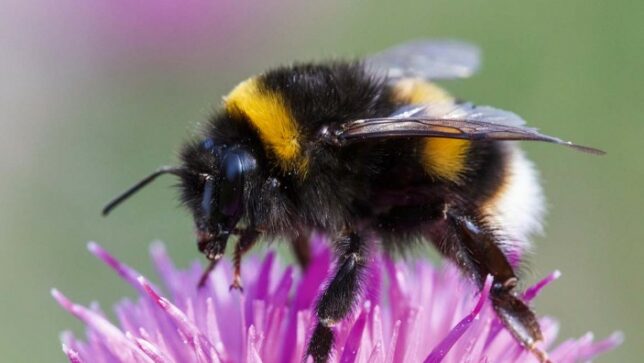Bumblebee colonies exposed to low levels of the weed killer glyphosate are unable to adequately regulate nest temperature, imperiling the next generation of bumblebees and long-term colony growth and survival. This latest finding, published this month in the journal Science, is a stark reminder that a pesticide does not have to kill an animal outright in order to create effects that ultimately result in death and population declines, Beyond Pesticides reported Wednesday.

“Sublethal effects, i.e. effects on organisms that are not lethal but can be seen, for example, in the animals’ physiology or behaviour, can have a significant negative impact and should be taken into account when pesticides are approved in future,” said Anja Weidenmüller, PhD, of the University of Konstanz, Germany. With regulators at the U.S. Environmental Protection Agency (EPA) refusing to adequately account for sublethal impacts, and myopically focused on the acute effects of pesticide exposure, bumblebee populations in the United States are in free fall and require urgent protective action.
To better understand how glyphosate exposure affects bumblebee colony growth and brood (young larval bee) development, researchers first split colonies in two. One side of the colony was fed sugar water containing 5mg/liter of glyphosate, while the other side was fed pure, unadulterated sugar water. This practice accounts for natural variation in strength that can occur between different bumblebee colonies. Although the colonies were separated by a mesh screen, each day the scientists switched the queens between the two sides.
Bees did not die from exposure to this level of glyphosate, living at least 32 days, a typical worker bumblebee life span. While bees exposed to glyphosate did display slightly reduced investment in brood development, the most outsized effect of glyphosate exposure was on colony thermoregulation. Bumblebee colonies require temperatures between 82.4°F and 95°F (28°C and 35°C) in order for eggs and brood to properly develop. “Just as we humans keep our body temperature constant, the animals in a colony collectively show homeostasis in the temperature regulation of their brood,” says Dr. Weidenmüller.
Glyphosate exposure alone did not impair thermoregulation, but when researchers dialed back on the sugar syrup, the effects became pronounced. Compared to the unexposed control colony halves, the sides treated with glyphosate dropped below 82.4°F much more rapidly. In sum, glyphosate-exposed sides maintained adequate brood conditions 26% less time than the unexposed side of the colony. Most of the contaminated sides had no region in the nest that was above the 82.4°F mark, and thus viable for new eggs. “When resources become scarce, you see very clearly that the collective thermal behaviour of colonies that have been chronically exposed to glyphosate is affected,” says Dr. Weidenmüller. “They cannot keep their brood warm for as long.”
Impairing nest thermoregulation has major knock-on effects that place the colony in existential danger. Even temperatures at 77°F reduce brood development speed by 50% of its potential maximum and give new eggs a success rate as low as 17%. “Bumblebee colonies are under really high pressure to grow as quickly as possible within a short period of time,” says Dr. Weidenmüller. “Only when they reach a certain colony size during the relatively short growth period are they able to produce the sexually reproductive individuals of a colony, i.e. queens and drones.” Further modeling of the study’s findings show that low temperatures are likely to further impair this process.
One of the most critical time in a colony’s development is after queen hibernation, when there is an urgent need to replenish their energy stores in order to start constructing a nest. Bumblebee queens waking up in the cold, early spring to relatively low floral resources, and a contaminated landscape represents a slow moving disaster that is likely playing out in regions across the world.
As it stands currently, the American bumblebee has experienced an 89% decline in its population over the last 20 years. The rusty patched bumblebee has seen a similar 91% decline since the 1990s and in 2017 was listed as endangered by the U.S. Fish and Wildlife Service under the Endangered Species Act.
Glyphosate is far from the only chemical stressor harming bumblebees. Systemic neonicotinoid insecticides represent an even more potent threat, posing both acute and chronic hazards to a range of pollinators. In fact, there is evidence that neonicotinoids pose a threat to bumblebees at every single step in their life stage.
Reinforcing the present study, research published in 2020 by researchers at University of California, Davis revealed that mason bees experiencing a combination of food scarcity and exposure to the neonicotinoid imidacloprid saw a 57% reduction in offspring, compared to unexposed bees.
In addition to a wide range of chemical exposure, and the lack of floral resources from development and industrialized agriculture, are the effects of climate change. A 2015 study published in Science determined that North American and European bumble bees are unable to colonize new warmer habitats north of their historic range, while simultaneously disappearing from the southern portions of their range.
At this point, it almost feels contrived to say that pollinator declines are a result of many factors. But it is critical to understand that chemical use is one of the most easily modifiable factors in this equation. Despite a profound body of independent, peer-reviewed literature associating various pesticides with a myriad of different lethal and sublethal effects on pollinator populations, EPA regulators are permitting the continued use of these hazardous chemicals.
Glyphosate and the neonicotinoids alone represent millions of pounds of pesticides applied throughout the United States. Although EPA has the power to order more comprehensive reviews that will result in actions that truly protect pollinators, it is repeatedly refused to do so. Not only that, we have seen that even the lackluster requirements added at the beginning of the pollinator crisis are falling by the wayside, as EPA skips over pollinator assessments while nonetheless declaring how “benefits…outweigh any remaining risk.”


















